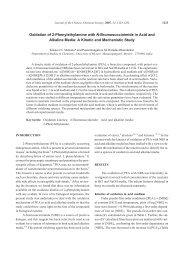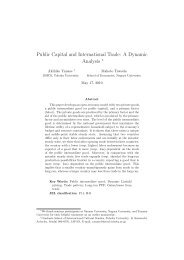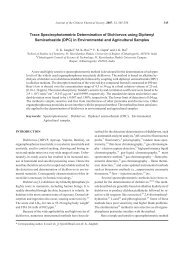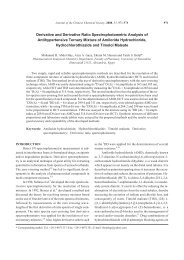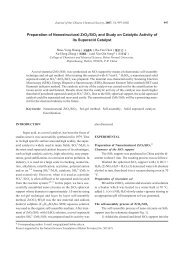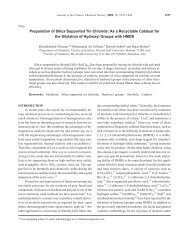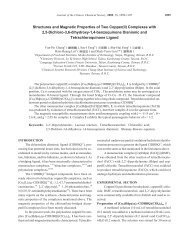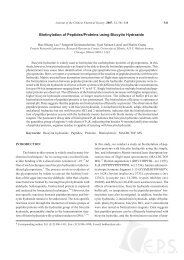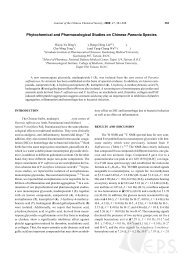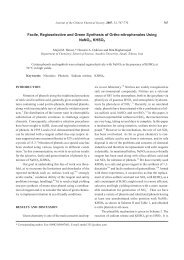Efficient and Convenient Oxidation of Organic Halides to Aldehydes ...
Efficient and Convenient Oxidation of Organic Halides to Aldehydes ...
Efficient and Convenient Oxidation of Organic Halides to Aldehydes ...
You also want an ePaper? Increase the reach of your titles
YUMPU automatically turns print PDFs into web optimized ePapers that Google loves.
28 Journal <strong>of</strong> the Chinese Chemical Society, 2010, 57, 28-33<br />
Communication<br />
<strong>Efficient</strong> <strong>and</strong> <strong>Convenient</strong> <strong>Oxidation</strong> <strong>of</strong> <strong>Organic</strong> <strong>Halides</strong> <strong>to</strong> <strong>Aldehydes</strong> <strong>and</strong><br />
Ke<strong>to</strong>nes Catalyzed by H 5 IO 6 /V 2 O 5 in Ionic Liquid [bmpy][PF 6 ]<br />
Yu-Lin Hu ( ), Xiang Liu ( ),<br />
Ming Lu* ( ) <strong>and</strong> Hui Jiang ( )<br />
Chemical Engineering College, Nanjing University <strong>of</strong> Science <strong>and</strong> Technology, Nanjing 210094, P. R. China<br />
A mild, efficient, <strong>and</strong> eco-friendly procedure for the oxidation <strong>of</strong> organic halides <strong>to</strong> aldehydes <strong>and</strong> ke<strong>to</strong>nes<br />
in good <strong>to</strong> high yields catalyzed by H 5 IO 6 /V 2 O 5 in ionic liquid [bmpy][PF 6 ] with no trace <strong>of</strong><br />
overoxidation <strong>to</strong> carboxylic acids has been developed. The product can be isolated by a simple extraction<br />
with organic solvent, <strong>and</strong> the catalytic system can be recycled or reused without any significant loss <strong>of</strong> catalytic<br />
activity.<br />
Keywords: <strong>Oxidation</strong>; <strong>Organic</strong> halide; H 5 IO 6 /V 2 O 5 ; Ionic liquid.<br />
INTRODUCTION<br />
<strong>Aldehydes</strong> <strong>and</strong> ke<strong>to</strong>nes are important classes <strong>of</strong> chemicals<br />
that have been used extensively as synthetic intermediates<br />
in the preparation <strong>of</strong> a variety <strong>of</strong> fine or special<br />
chemicals such as drugs, vitamins, fragnances, etc. 1 Up <strong>to</strong><br />
now, many publications in the open literature have been<br />
found in synthesis <strong>of</strong> these type <strong>of</strong> compounds, <strong>and</strong> a well<br />
known method for such a synthesis constitutes the oxidation<br />
<strong>of</strong> benzyl halides. 2,3 Hass-Bender reaction 4,5 <strong>and</strong><br />
Sommelet reaction 6 are two classic methods for such a conversion.<br />
While each has some limitations, the former<br />
method is only satisfied for para-substituted substrates, the<br />
latter unfortunately has limited substrate scope. Various<br />
reagents employed as the oxygen donors have been developed<br />
for this conversion include dimethyl sulfoxide<br />
(DMSO), 7,8 N,N-dimethyl-4-nitrosoaniline, 9 nitronate anion<br />
<strong>and</strong> Pd(PPh3), 10 pyridine N-oxides, 11 amine oxides, 12,13<br />
N-alkoxypyridinium salts, 14,15 silver nitrate, 16 potassium<br />
chromate, 17 pyrazinyl sulfoxides, 18 NaIO 4 -DMF, 19 selenium<br />
compounds, 20 etc. 21-25 However, some <strong>of</strong> these procedures<br />
are invariably associated with one or more disadvantages<br />
such as long reaction time, high temperature, low<br />
yields, harmful <strong>to</strong> the environment, etc. Consequently,<br />
there is a great need <strong>to</strong> develop new <strong>and</strong> environment-benign<br />
procedures that address these drawbacks for such a<br />
conversion.<br />
Ionic liquids (ILs) are a class <strong>of</strong> organic salts with unusually<br />
low melting temperatures that have attracted much<br />
attention from the scientific community in recent years. As<br />
a class <strong>of</strong> potential greener solvents, ILs exhibit many<br />
unique physicochemical properties, such as negligible volatility<br />
<strong>and</strong> nonflammability under ambient conditions,<br />
large liquid range, high thermal stability, wide electrochemical<br />
window, <strong>and</strong> strong ability <strong>to</strong> dissolve many<br />
chemicals. 26,29 Therefore, ILs have found wide applications<br />
in chemical synthesis, 27-29 biocatalytic transformations,<br />
30,31 electrochemistry, 32 <strong>and</strong> analytical <strong>and</strong> separation<br />
science. 33,34<br />
In continuation <strong>of</strong> our interest in exploring green oxidation<br />
in ionic liquids, we herein report a mild <strong>and</strong> effective<br />
procedure for the selective oxidation <strong>of</strong> organic halides <strong>to</strong><br />
aldehydes <strong>and</strong> ke<strong>to</strong>nes with H 5 IO 6 /V 2 O 5 using 1-butyl-3-<br />
methylimidazolium hexafluorophosphorate ([bmpy][PF 6 ])<br />
as the solvent (Scheme I). Furthermore, we demonstrate<br />
that the catalytic system can be recycled <strong>and</strong> reused without<br />
any significant loss <strong>of</strong> catalytic activity.<br />
Scheme I<br />
* Corresponding author. Tel: +86-025-84315030; Fax: +86-025-84315030; E-mail: luming1963@163.com
<strong>Oxidation</strong> <strong>of</strong> <strong>Organic</strong> <strong>Halides</strong> by H 5 IO 6 /V 2 O 5 /[bmpy][PF 6 ] J. Chin. Chem. Soc., Vol. 57, No. 1, 2010 29<br />
Table 1. Optimization <strong>of</strong> the reaction conditions for oxidizing 1-<br />
(chloromethyl)-4-methylbenzene <strong>to</strong> 4-methylbenzaldehyde<br />
a<br />
Entry Catalyst Ionic liquid Time (h) Yield (%) b<br />
1 V 2 O 5 [bmim]BF 4 7 74<br />
2 V 2 O 5 [bmim]Cl 8 68<br />
3 V 2 O 5 [hmim]OTf 6 76<br />
4 V 2 O 5 [hmim]PF 6 6 83<br />
5 V 2 O 5 [bmpy]PF 6 3 97<br />
6 V 2 O 5 [bpy]PF 6 3 89<br />
7 V 2 O 5 [bmpy]PF 6 3 97 c<br />
8 V 2 O 5 [bmpy]PF 6 3 96 d<br />
9 V 2 O 5 10 53<br />
10 [bmpy]PF 6 6 48<br />
a Reaction conditions: 1-(chloromethyl)-4-methylbenzene (10<br />
mmol), V 2 O 5 (0.3 mmol), H 5 IO 6 (12 mmol), ionic liquid 5 mL, 50<br />
°C. b Isolated yield. c The second run. d The third run.<br />
RESULTS AND DISCUSSION<br />
The initial study was carried out using 1-(chloromethyl)-4-methylbenzene<br />
as the substrate <strong>to</strong> optimize the<br />
reaction conditions, <strong>and</strong> the results are summarized in Table<br />
1. At first, six type <strong>of</strong> ionic liquids, 1-butyl-3-methylimidazolium<br />
tetrafluoroborate ([bmim]BF 4 ), 1-butyl-3-<br />
methylimidazolium chloride ([bmim]Cl), 1-hexyl-3-methylimidazolium<br />
trifluoromethansulfonate ([hmim]OTf),<br />
1-hexyl-3-methylimidazolium hexafluorophosphate<br />
([hmim]PF 6 ), 1-butyl-4-methylpyridinium hexafluorophosphate<br />
([bmpy]PF 6 ), <strong>and</strong> butylpyridinium hexafluorophosphorate<br />
([bpy]PF 6 ), were tested with V 2 O 5 as the catalyst<br />
precursor in the reaction (Table 1, entries 1-6), it was observed<br />
that [bmpy]PF 6 demonstrated the best performance,<br />
providing a 97% high yield (Table 1, entry 5). The different<br />
effects <strong>of</strong> ILs in the reaction may be attributed <strong>to</strong> their different<br />
abilities <strong>of</strong> stabilizing <strong>and</strong> dissolving the oxidant<br />
H 5 IO 6 <strong>and</strong> the catalyst V 2 O 5 . Under the same conditions,<br />
the IL who stabilizes <strong>and</strong> dissolves them more easily will<br />
leads <strong>to</strong> a larger increase in the effective reactant concentration,<br />
which increases the encounter probabilities between<br />
the substrate <strong>and</strong> reactive species, <strong>and</strong> so the higher<br />
rate <strong>and</strong> yield <strong>of</strong> the reaction is observed. In addition, the<br />
catalytic system could be typically recovered <strong>and</strong> reused<br />
with no appreciable decrease in yields <strong>and</strong> reaction rates<br />
(Table 1, entries 7 <strong>and</strong> 8). Furthermore, the catalyst V 2 O 5<br />
<strong>and</strong> the solvent [bmpy]PF 6 are crucial for this oxidation,<br />
<strong>and</strong> the lack <strong>of</strong> any component leads <strong>to</strong> a lower yield (Table<br />
1, entries 9 <strong>and</strong> 10). In addition, no over-oxidized product<br />
(4-methylbenzoic acid) was detected by 1 H NMR analysis<br />
<strong>of</strong> the crude reaction mixtures in all the cases.<br />
With these results in h<strong>and</strong>, the catalytic system was<br />
then applied <strong>to</strong> various organic halides as summarized in<br />
Table 2. It is clear that various types <strong>of</strong> benzylic <strong>and</strong> allylic<br />
halides, both primary <strong>and</strong> secondary, have been successfully<br />
oxidized <strong>to</strong> the corresponding aldehydes <strong>and</strong> ke<strong>to</strong>nes<br />
in good <strong>to</strong> high yields (Table 2, entries 1-19), whereas the<br />
aliphatic halides were less reactive, <strong>and</strong> the reactions proceeded<br />
more slowly, <strong>and</strong> even under more drastic reaction<br />
conditions, the reactions were still incomplete (Table 2, entries<br />
20 <strong>and</strong> 21). Surprisingly, the oxidation <strong>of</strong> primary<br />
halides <strong>to</strong> the corresponding carbonyl compounds is faster<br />
<strong>and</strong> more efficient than secondary halides (Table 2, entries<br />
13-15 <strong>and</strong> 17). This is not in agreement with reactions performed<br />
in classical organic solvents, 19,22,23 which are excellent<br />
results for a V 2 O 5 -catalyzed halide oxidation performed<br />
in an ionic liquid. Further, the reaction is faster with<br />
benzyl chlorides than with benzyl bromides (Table 2, entries<br />
2 <strong>and</strong> 3). In addition, the electron deficiency <strong>and</strong> nature<br />
<strong>of</strong> the substituents on the aromatic ring have influence<br />
on the oxidation rate, benzylic halides having electronwithdrawing<br />
groups on the aromatic ring (Table 2, entries<br />
9, 13 <strong>and</strong> 16) react more slowly than those having electron-donating<br />
groups (Table 2, entries 2-8 <strong>and</strong> 10).<br />
A possible mechanism for the oxidation <strong>of</strong> organic<br />
halides, similar <strong>to</strong> that <strong>of</strong> alcohols catalyzed by H 2 O 2 /V 2 O 5 ,<br />
proposed by Butler <strong>and</strong> co-workers, 35 isshowninScheme<br />
II. In acidic solution, V 2 O 5 can exist as VO 2 + <strong>and</strong> VO 3 at<br />
first. Addition <strong>of</strong> H 5 IO 6 <strong>to</strong> VO 2 + can give the red oxoperoxo<br />
Scheme II Possible mechanism for the oxidation <strong>of</strong> organic<br />
halides
30 J. Chin. Chem. Soc., Vol. 57, No. 1, 2010 Hu et al.
<strong>Oxidation</strong> <strong>of</strong> <strong>Organic</strong> <strong>Halides</strong> by H 5 IO 6 /V 2 O 5 /[bmpy][PF 6 ] J. Chin. Chem. Soc., Vol. 57, No. 1, 2010 31<br />
VO(O 2 ) + (I) <strong>and</strong> the yellow oxodiperoxo VO(O 2 ) 2 species<br />
(II), which reacts with organic halide <strong>to</strong> form transition<br />
state (III) <strong>and</strong>then,III eliminated the oxoperoxo (I) <strong>and</strong><br />
H + <strong>to</strong> yield the desired product. The low activities <strong>of</strong> the<br />
secondary halides might be attributed <strong>to</strong> steric effects <strong>of</strong> the<br />
complex II, <strong>and</strong> which suggests that II is a bulky nucleophile<br />
<strong>and</strong> is sensitive <strong>to</strong> steric hindrance. The reason why<br />
benzyl chlorides reacted faster than that <strong>of</strong> benzyl bromides<br />
possibly lies that II is such a good leaving group that<br />
it is more easily substituted by the better nucleophile, bromide<br />
ion, than by the chloride ion. It looks like that the formation<br />
<strong>of</strong> III between II <strong>and</strong> organic halide is the rate-determining<br />
step.<br />
CONCLUSIONS<br />
In conclusion, we have demonstrated an efficient <strong>and</strong><br />
selective oxidation <strong>of</strong> organic halides <strong>to</strong> aldehydes <strong>and</strong> ke<strong>to</strong>nes<br />
by using H 5 IO 6 /V 2 O 5 catalyst system in the ionic liquid<br />
[bmpy]PF 6 . Most importantly, the catalysts are very<br />
easy <strong>to</strong> h<strong>and</strong>le <strong>and</strong> can be recycled <strong>and</strong> reused without any<br />
significant loss <strong>of</strong> catalytic activity. The scope, the defination<br />
<strong>of</strong> the mechanism, <strong>and</strong> synthetic applications <strong>of</strong> the oxidation<br />
are currently under investigation.<br />
EXPERIMENTAL<br />
Apparatus <strong>and</strong> reagents<br />
All the used chemicals were from commercial sources<br />
without any pretreatment. All reagents were <strong>of</strong> analytical<br />
grade. The ionic liquids were synthesized according <strong>to</strong> the<br />
literature procedures. 28,32,36 The reduced pressure distillation<br />
were performed on a micro-distillation apparatus<br />
(Model MRS 255). Melting points were recorded on a<br />
Buchi R-535 apparatus <strong>and</strong> are uncorrected. 1 HNMRspectra<br />
were recorded on a Bruker 400-MHz spectrometer using<br />
CDCl 3 as the solvent with tetramethylsilane (TMS) as<br />
an internal st<strong>and</strong>ard. Elemental analysis were performed on<br />
a Vario EL III instrument (Elmentar Anlalysensy Teme<br />
GmbH, Germany).<br />
General procedure for the oxidation <strong>of</strong> organic<br />
halides<br />
To a stirred solution <strong>of</strong> organic halide (10 mmol) in<br />
ionic liquid [bmpy]PF 6 (5 mL) was added H 5 IO 6 (12 mmol)<br />
<strong>and</strong> V 2 O 5 (0.3 mmol) at room temperature <strong>and</strong> stirring was<br />
continued at 50 °C for the appropriate time (Table 2). After<br />
completion <strong>of</strong> the reaction, as indicated by TLC, the product<br />
was extracted with dichloromethane (3 × 10 mL). The<br />
combined organic layer was washed <strong>to</strong> neutral with 5%<br />
NaHCO 3 solution (3 × 10 mL ) <strong>and</strong> water (3 × 10 mL), <strong>and</strong><br />
then dried over anhydrous Na 2 SO 4 . The solvent was removed<br />
<strong>and</strong> the residue was distilled under vacuum <strong>to</strong> give<br />
the desired pure product. The rest <strong>of</strong> the ionic liquid <strong>and</strong> the<br />
catalyst were recovered by decantation <strong>of</strong> aqueous hydrogen<br />
halide produced in the reaction <strong>and</strong> concentration under<br />
vacuum. Fresh subtrates were then recharged <strong>to</strong> the recovered<br />
catalyst system <strong>and</strong> then recycled under identical<br />
reaction conditions. The target substrates were characterized<br />
by Elemental analysis, 1 H NMR or compared with<br />
their authentic samples. Spectroscopic data for selected<br />
products is as follows.<br />
4-Methylbenzaldehyde (2)<br />
Colourless oil. 1 H NMR (400 MHz, CDCl 3 ): 2.24<br />
(s, CH 3 ,3H),7.32(d,J = 7.6 Hz, Ar-H, 2H), 7.68 (d, J =7.6<br />
Hz, Ar-H, 2H), 9.96 (s, CHO, 1H). Anal. Calcd for C 8 H 8 O:<br />
C, 79.94; H, 6.72; O, 13.33. Found: C, 79.97; H, 6.71; O,<br />
13.32.<br />
2-Isopropylbenzaldehyde (4)<br />
Colourless oil. 1 H NMR (400 MHz, CDCl 3 ): 1.28<br />
(d, J =7.8Hz,CH 3 , 6H), 2.98 (m, CH, 1H), 7.49-7.99 (m,<br />
Ar-H, 4H), 9.86 (s, CHO, 1H). Anal. Calcd. for C 10 H 12 O:<br />
C, 80.97; H, 8.15; O, 10.82. Found: C, 81.04; H, 8.16; O,<br />
10.80.<br />
4-Tert-butylbenzaldehyde (5)<br />
Colourless oil. 1 H NMR (400 MHz, CDCl 3 ): 1.31<br />
(s, CH 3 , 9H), 7.53-7.79 (m, Ar-H, 4H), 9.96 (s, CHO, 1H).<br />
Anal. Calcd. for C 11 H 14 O: C, 81.38; H, 8.71; O, 9.85.<br />
Found: C, 81.44; H, 8.70; O, 9.86.<br />
2,4,6-Trimethylbenzaldehyde (6)<br />
Colourless oil. 1 H NMR (400 MHz, CDCl 3 ): 2.17<br />
(s, CH 3 ,3H),2.43(s,CH 3 , 6H), 7.24 (s, Ar-H, 2H), 9.91 (s,<br />
CHO, 1H). Anal. Calcd. for C 10 H 12 O: C, 81.03; H, 8.17; O,<br />
10.77. Found: C, 81.04; H, 8.16; O, 10.80.<br />
3,4-(Methylenedioxy)-benzaldehyde (7)<br />
White solid, mp: 36-38 °C. 1 H NMR (400 MHz,<br />
CDCl 3 ): 6.04 (s, CH 2 , 2H), 6.86-7.53 (m, Ar-H, 3H), 9.86<br />
(s, CHO, 1H). Anal. Calcd for C 8 H 6 O 3 : C, 63.99; H, 4.01;<br />
O, 31.98. Found: C, 64.00; H, 4.03; O, 31.97.<br />
3,4,5-Trimethoxybenzaldehyde (8)<br />
White solid, mp: 74-76 °C. 1 H NMR (400 MHz,<br />
CDCl 3 ): 3.77 (s, CH 3 O, 3H), 3.92 (s, CH 3 O, 6H), 7.12-<br />
7.16 (s, Ar-H, 2H), 9.86 (s, CHO, 1H). Anal. Calcd for<br />
C 10 H 12 O 4 : C, 61.18; H, 6.17; O, 32.64. Found: C, 61.22; H,<br />
6.16; O, 32.62.
32 J. Chin. Chem. Soc., Vol. 57, No. 1, 2010 Hu et al.<br />
4-Methoxybenzaldehyde (10)<br />
Colourless oil. 1 H NMR (400 MHz, CDCl 3 ): 3.96<br />
(s, CH 3 O, 3H), 7.37 (d, J = 7.9 Hz, Ar-H, 2H), 7.72 (d, J =<br />
7.9 Hz, Ar-H, 2H), 9.97 (s, CHO, 1H). Anal. Calcd for<br />
C 8 H 8 O 2 : C, 70.54; H, 5.92; O, 23.51. Found: C, 70.57; H,<br />
5.92; O, 23.50.<br />
3,7-Dimethyl-2,6-octadienal (12)<br />
Colorless liquid. 1 H NMR (400 MHz, CDCl 3 ): 1.57<br />
(s, CH 3 ,3H),1.91(s,CH 3 ,3H),2.23(s,CH 3 ,3H),2.61(m,<br />
CH 2 CH 2 ,4H),5.10(s,CH,1H),5.85(d,J = 7.0 Hz, CH,<br />
1H), 9.80 (d, J = 7.0 Hz, CHO, 1H). Anal. Calcd for<br />
C 10 H 16 O: C, 78.87; H, 10.59; O, 10.52. Found: C, 78.90; H,<br />
10.59; O, 10.51.<br />
1-(4-Fluorophenyl)ethanone (13)<br />
Colourless oil. 1 H NMR (400 MHz, CDCl 3 ): 2.53<br />
(s, CH 3 ,3H), 7.27-7.31 (m, Ar-H, 2H), 7.96-8.03 (m, Ar-H,<br />
2H). Anal. Calcd. for C 8 H 7 FO: C, 69.51; H, 5.07; F, 13.74;<br />
O, 11.59. Found: C, 69.56; H, 5.11; F, 13.75; O, 11.58.<br />
Propiophenone (14)<br />
Colourless oil. 1 H NMR (400 MHz, CDCl 3 ): 1.23 (t,<br />
J =7.2Hz,CH 3 ,3H),3.48(q,J =7.8Hz,CH 2 ,2H),<br />
7.37-7.54 (m, Ar-H, 3H), 7.88-7.94 (m, Ar-H, 2H). Anal.<br />
Calcd for C 9 H 10 O: C, 80.51; H, 7.53; O, 11.92. Found: C,<br />
80.56; H, 7.51; O, 11.92.<br />
Benzophenone (15)<br />
White solid, mp: 47-48 °C. 1 H NMR (400 MHz,<br />
CDCl 3 ): 7.31-7.56 (m, Ar-H, 6H), 7.93-8.02 (m, Ar-H,<br />
4H). Anal. Calcd for C 13 H 10 O: C, 85.65; H, 5.53; O, 8.79.<br />
Found: C, 85.69; H, 5.53; O, 8.78.<br />
4-Nitro-benzaldehyde (16)<br />
Light yellow solid, mp: 104-106 °C. 1 H NMR (400<br />
MHz, CDCl 3 ): 8.11-8.34 (m, Ar-H, 4H), 10.22 (s, CHO,<br />
1H). Anal. Calcd for C 7 H 5 NO 3 : C, 55.61; H, 3.34; N, 9.26;<br />
O, 31.77. Found: C, 55.63; H, 3.33; N, 9.27; O, 31.76.<br />
trans-Cinnamaldehyde (18)<br />
Colourless oil. 1 H NMR (400 MHz, CDCl 3 ): 6.65<br />
(d, J = 16.7 Hz, CH, 1H), 6.69 (dd, J = 6.5, 16.7 Hz, CH,<br />
1H), 7.36-7.51 (m, Ar-H, 5H), 9.65 (d, J = 6.5 Hz, CHO,<br />
1H). Anal. Calcd for C 9 H 8 O: C, 81.79; H, 6.10; O, 12.11.<br />
Found: C, 81.79; H, 6.10; O, 12.11.<br />
2-Octanone (20)<br />
Colourless oil. 1 H NMR (400 MHz, CDCl 3 ): 0.90 (t,<br />
J =7.0Hz,CH 3 ,3H),1.30(m,CH 2 ,6H),1.56(m,CH 2 ,<br />
2H), 2.16 (s, CH 3 ,3H),2.44(m,CH 2 ,2H).Anal.Calcdfor<br />
C 8 H 16 O: C, 74.91; H, 12.57; O, 12.49. Found: C, 74.94; H,<br />
12.58; O, 12.48.<br />
ACKNOWLEDGEMENTS<br />
We thank the National Basic Research Program (973)<br />
<strong>of</strong> China (No. 613740101) <strong>and</strong> Natural Science Foundation<br />
<strong>of</strong> Jiangsu Province for supporting this research.<br />
Received November 8, 2009.<br />
REFERENCES<br />
1. Epstein, W. W.; Sweat, F. W. Chem. Rev. 1967, 67, 247.<br />
2. Smith,M.B.;March,J. Advanced <strong>Organic</strong> Chemistry: Reactions,<br />
Mechanisms, <strong>and</strong> Structure; John Wiley: New York,<br />
2001; pp 1535-1536.<br />
3. Larock,R.C. Comprehensive <strong>Organic</strong> Transformations;<br />
John Wiley: New York, 1999; pp 1222-1223.<br />
4. Hass, H. B.; Bender, M. L. J. Am. Chem. Soc. 1949, 71,<br />
1767-1769.<br />
5. Kl<strong>and</strong>erman,B.H. J. Org. Chem. 1966, 31, 2618.<br />
6. Campaigne,E.;Lesuer,W.M. J. Am. Chem. Soc. 1948, 70,<br />
1555-1558.<br />
7. Kornblum, N.; Jones, W. J.; Anderson, G. J. J. Am. Chem.<br />
Soc. 1959, 81, 4113-4114.<br />
8. Nace, H. R.; Monagle, J. J. J. Org. Chem. 1959, 24, 1792-<br />
1793.<br />
9. Krohnke, F. Angew Chem. Int. Ed. 1963, 2, 380-393.<br />
10. Suzuki, S.; Onishi, T.; Fujita, Y.; Otera, J. Synth. Commun.<br />
1985, 15, 1123-1128.<br />
11. Mukaiyama, S.; Inanaga, J.; Yamaguchi, Y. Bull. Chem. Soc.<br />
Jpn. 1981, 54, 2221-2229.<br />
12. Ch<strong>and</strong>rasekhar, S.; Sridhar, M. Tetrahedron Lett. 2000, 41,<br />
5423-5425.<br />
13. Harry,W.J.J.;Henry,C.K. J. Org. Chem. 1967, 32, 1939-<br />
1941.<br />
14. Godfrey, A. G.; Ganem, B. Tetrahedron Lett. 1990, 31,<br />
4825-4826.<br />
15. Shukla, D.; Ahearn, W. G.; Farid, S. J. Org. Chem. 2005, 70,<br />
6809-6819.<br />
16. Brown, R. E.; Hansen, H. V.; Lustgarten, D. M.; Stanaback,<br />
R. J.; Meltzer, R. I. J. Org. Chem. 1968, 33, 4180-4184.<br />
17. Bois, F.; Berod, A.; Chermette, H.; Pujol, J. F.; Blond, P.<br />
Microchim. Acta 1978, 11, 221-227.<br />
18. Shimazaki, M.; Nakanishi, T.; Mechizuki, M.; Ohata, A.<br />
Heterocycles 1988, 27, 1643-1647.<br />
19. Das,S.;Panigrahi,A.K.;Maikap,G.C. Tetrahedron Lett.<br />
2003, 44, 1375-1377.<br />
20. Syper, L.; Mlochowski, J. Synthesis 1984, 747-751<br />
21. Moorthy, J. N.; Singhal, N.; Senapati, K. Tetrahedron Lett.<br />
2006, 47, 1757-1761.<br />
22. Tang, J. T.; Zhu, J. L.; Shen, Z. X.; Zhang, Y. W. Tetrahedron<br />
Lett. 2007, 48, 1919-1921.
<strong>Oxidation</strong> <strong>of</strong> <strong>Organic</strong> <strong>Halides</strong> by H 5 IO 6 /V 2 O 5 /[bmpy][PF 6 ] J. Chin. Chem. Soc., Vol. 57, No. 1, 2010 33<br />
23. I<strong>to</strong>h, A.; Kodana, T.; Inagaki, S.; Masaki, Y. Org. Lett. 2000,<br />
2, 2455-2457.<br />
24. Liu, Q. F.; Lu, M.; Sun, F.; Li, J.; Zhao, Y. B. Synth.<br />
Commun. 2008, 38, 4188-4197.<br />
25. Khodaei, M. M.; Khosropour, A. R.; Jowkar, M. Synthesis<br />
2005, 1301-1304.<br />
26. Saravanababu, M.; Robert, J. L. Curr. Org. Synth. 2005, 2,<br />
437-451.<br />
27. Dupont, J.; de Souza, R. F.; Suarez, P. A. Z. Chem. Rev.<br />
2002, 102, 3667.<br />
28. Wasserschein, P.; Wel<strong>to</strong>n, T. Ionic Iiquids in Synthesis;<br />
Wiley-VCH: Weinhein, 2003.<br />
29. Martins, M. A. P.; Frizzo, C. P.; Moreira, D. N.; Zanatta, N.;<br />
Bonacorso, H. G. Chem. Rev. 2008, 108, 2015.<br />
30. Chen,Y. K.; Jin, C. X.; Wang, Y. L.; Wang, J. Y. J. Chin.<br />
Chem. Soc. 2006, 53, 677-681.<br />
31. Hajipour, A. R.; Khazdooz, L.; Ruoho, A. E. Catal.<br />
Commun. 2008, 9, 89.<br />
32. Balducci, A.; Henderson, W. A.; Mastragostino, M.;<br />
Passerini, S.; Simon, P.; Soavi, F. Electrochim. Acta 2005,<br />
50, 2233.<br />
33. Dubois, P.; March<strong>and</strong>, G.; Fouillet, Y.; Berthier, J.; Douki,<br />
T.; Hassine, F.; Gmouh, S.; Vaultier, M. Anal. Chem. 2006,<br />
78, 4909.<br />
34. Zheng, J.; Row, K. H. Am.J.Appl.Sci.2006, 3, 2160-2166.<br />
35. Butler, A.; Clague, M. J.; Meister, G. E. Chem. Rev. 1994,<br />
94, 625-638.<br />
36. Zhang, S. J.; Lu, X. M. Ionic Liquids: From Fundamental<br />
Research <strong>to</strong> Industrial Applications; Science Press: Beijing,<br />
2006.



